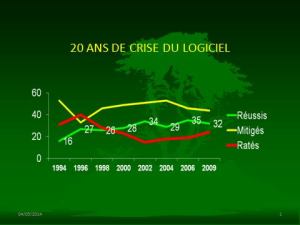1. A program = an expertise
Any program is the automation of a human expertise. Payroll is the automation of an accounting expertise, device drivers are automation of engineering expertises, input screen are automation of ergonomist expertise crossed with programmer expertise, electronic mail is automation of users expertise, databases management system are the automation of computer expertises, etc.. And if you want to develop a program without having an expert close at hand, you will obliged to create the expertise what will make you an expert …
Of course, expertise contained in a program is usually complex, rare and essential. This is because it is complex that its users, however daily, fail to assimilate. This is because it is rare that it must be saved in a program in order not to lose it when the expert will disappear. This is because it is daily essential for users that they need a program that helps and saves them time.
We saw in my previous post « Algorithmic, sad consequence of the wrong postulate that computer is stupid » an algorithmic program is the identification of all possible ways of reasoning to solve a given class of problems. For collecting these arguments, the computer scientist is forced to simulate the operation of the expertise in his head, therefore to learn it and understand it. This is an almost superhuman exercise because, remember, the users themselves, yet familiar with the subject, do not succeed.
When he considers that he has fully assimilated the expertise, the programmer begins a new unhuman task: to represent all the paths that can be taken in a kind of equation : the algorithmic. This work will fill dozens or hundreds of pages depending on the volume of the expertise and the result must always work. We understand that writing a program is not a long calm river …
2. Human procedural memory and expertises
The computer can store an infinite number of pages without forgetting anything but man not at all. However this does not prevent him to achieve the same results and we would do well to learn from this ! He uses his simplifying intelligence and his « procedural » memory. This memory , possessed by all living things, stores repeated experiences and tells instantly what to do in front of known cases. It is the memory of the expert ( knowing that we are all experts in a multitude of things). The man pushed this feature much further than his colleagues animals. The evolution helped him by increasing its cranial capacity at a surprisingly fast speed in his last few hundred thousand years. In fact since he stands up which helped lay the weight of his heavy head on the rest of the body minimizing efforts, rather than a door-to-front overhang head like all animals moving horizontal.
Procedural memory consists of a multitude of micro-expertises that say what to do based on a given situation. The oldest and most common in a human are the language, the interpretation of expressions, psychology, driving, etc. Here are examples of human micro-made expertises in various specialized areas:
IF number of salary hours to pay> legal number of monthly hours
AND POSITION OF EMPLOYEE is not « executive »
THEN there are overtime to pay
IF you are in the area of Toulon-Camarat
AND wind force after breezes <4
AND wind direction after breeze > 2 and <6
WHEN the wind is northerly
IF the pain I feel does not mention a heart problem
AND it does not increase when I breathe
AND I do not have fever
AND I cough
THEN I have a pleurisy
IF I have an accident at an intersection
AND the other vehicle is on a roundabout
AND this roundabout has a sign « Give way »
AND I do not still circulating on the roundabout
THEN I am driving into the roundabout
AND I do not have priority
AND my share of responsibility in the accident = 1
In computer science and artificial intelligence, they are called « rules ». You collect all the rules of an expertise in a database which is called « rules base » or « knowledge base » . It is on them that the expert reasons unconsciously to execute an equivalent of the program, as for example we all reason unconsciously to understand this text, or to talk or to drive.
3 .Expertise = artificial intelligence
It turns out that, contrary to what many believe, each reasoning is a very simple mechanical. A mechanical as unconscious as a rule but with a power much greater since guide our actions every second and it is what keeps us alive. This is the « syllogism » described by Aristotle there 2400 years. You can discover its extraordinary power in this post. Since this is a simple and clear mechanical, it is programmable ! And this program knows how to exploit a rule base and reason on it like the expert. Even better than him because it never forgets anything, never makes a mistake and answered without the slightest delay.
By copying the thought process of the expert and provided that we have a rule base, we obtain a program without the intervention of a programmer, without algorithmic or computer language. We have a program written in clear under form of rules and easy to modify. The computer works out the rules without understanding the concepts it manipulates and yet it provides you the right answers that it does not understand either. But, you, you understand ! Like any program.
Remains to solve the ultimate challenge : to allow the computer to automatically find these rules it does not understand … Otherwise we will always have to use a developer to query the expert, and he will always have to assimilate knowledge for divide it into rules. Remember the topic of this post : « Another major flaw of computing: the obligation for the developer to learn the knowledge of experts to put in the programs ». It implies that it would be possible to program without understanding anything about the knowledge of the expert, so without even understanding the expert. God ! How is this possible ?
4. « La Maïeutique », a method to produce AI without any computer skills
That is here where my invention « La Maieutique » gains its value. It is a method, therefore also mechanical. It allows the computer to question experts and automatically extract their expertise in the form of rules. If the computer does not understand what it does, the expert, he can see the rules that are synthesized and can check if it has « understood » . If it does not understand the expert corrects.
With La Maieutique the computer is a force of proposal and the expert is the inspector of finished work. The machine proposes, the woman – sorry, the man! – disposes (for once). This really is the most comfortable way of working .
This means that with La Maieutique the expert defines the program and the computer writes it without understanding.
Not nice this invention?
You will guess that I am not loved by computer scientists ! 😉





